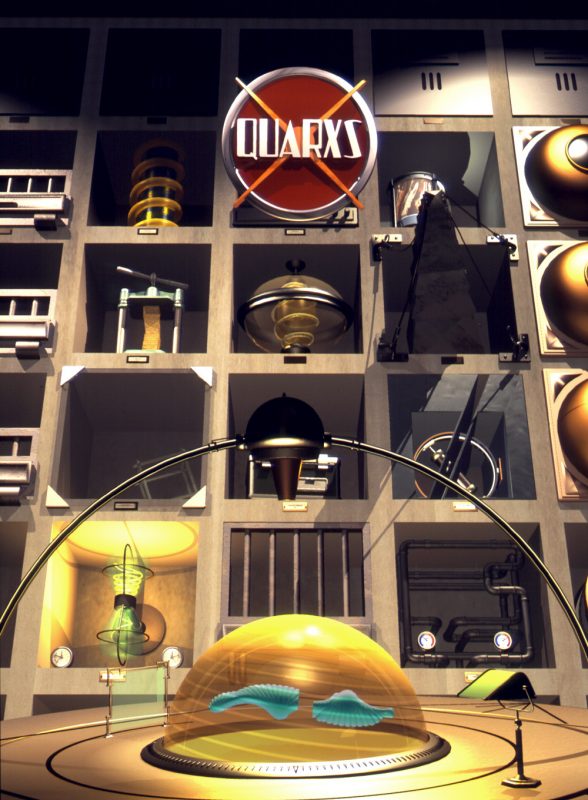
The first Helloween album is a classic of German power/speed metal. “Ride the Sky” in particular is one the most ripped-off songs ever. It was white-hot innovative in 1985 and still listens pretty well today.
On the back of albums like this, Germany was the dominant country for power metal through the 80s, 90s and 2000s. (In later decades it ceded space to Finland and Sweden, which is also when the genre stopped being worth listening to, for the most part). There’s a “Teutonic” PM style you can easily recognize: Judas Priest style songwriting with lots of 16th note picked-riffs, and “rough” vocals that are more enthusiastic than good. This regional style is highly distinctive: you can typically say “yep, this power metal band’s from Germany” a few seconds after the needle falls.
Kai Hansen and Michael Weikath go about 50-50 on the songwriting (most of the songs were written years earlier than 1985, for various proto-Helloween bands). Hansen’s efforts are stronger, probably because he has to sing them and better knows the limitations of his voice. “Ride the Sky” is an excellent opener, full of energy and riffs. (Also, is it the first known example of a power metal band rhyming fly with sky?) “Phantoms of Death” has wicked riffs and an excellent gang vocal chorus. It features a keyboard line, like a preview of the direction they’d take on their next album. Check out the Iron Savior cover, too. “Gorgar” (which was written in 1981) has a silly, humorous tone: Running Wild and Blind Guardian certainly weren’t writing songs about pinball boards at this point. Helloween’s lightness set them apart from other bands – they weren’t serious about what they did, which sometimes helped them and sometimes didn’t. They have a lot of nerve crediting the intro track to “Weikath/Hansen” when it’s just the melody of “London Bridge Is Falling Down”.
Weikath’s songs are good but are all the exact same tempo (“Reptile” excluded), making them a slightly repetitive. “Heavy Metal” is a Scanner kind of song, and “How Many Tears” is rampaging and furious epic, running a bit long at seven minutes. Hansen’s voice just doesn’t work here – he sounds ragged and out of breath in the climactic chorus. “Tears” more than any song demonstrated that the band needed to find a dedicated singer.
There’s a few different versions of Walls of Jericho hanging around. The original 1985 Noise LP is the definitive version. The 1987 CD edition has a bunch of extra songs, but it doesn’t listen as well: “Starlight” is worse than “Ride the Sky”, and “Judas” and “Murderer” have the exact same chorus (the songs are tracklisted at opposite sides of the CD, in the hopes you won’t notice!) I really love “Warrior”. Hansen is in total command here. “Silent falls the hammer!”
Production values? What are they? You hear reverb-drenched Marshalls and not much else. Whenever the songs get fast or busy, the music kind of flies to pieces in your auditory canal like a pinata, but that’s much-loved tradition of Teutonic PM too.
(It’s also a tradition to have questionable band names. Helloween got its name because, as Hansen explained once, “Halloween comes but once a year, but you can have Helloween every day“. It’s actually one of the better names Germany has to offer: other bands include Chinchilla, Edguy, Pink Cream 69, and…ugh…Custard.)

Quarxs is an early computer-animated TV show from 1990. It was produced three years before VeggieTales and Insektors, four years before ReBoot, five years before Toy Story, and thirty-two years before Morbius.
Created by digital artist Maurice Benayoun, it’s a fake documentary showcasing imaginary lifeforms called Quarxs. They have a strange relationship with space and time, and their behavior in the physical world is peculiar. For example, the Elasto-fragmentoplast wraps around small curved objects and smashes them, while also turning liquids into solids. The Spiro Thermophage lives in pipes and causes hot water to flow faster than cold water. And so on.
Basically, the Quarxs are gods of the gaps. Everything confusing about our universe (from dark matter to the missing socks in tumble-dryer) is directly or indirectly caused by them. The show consists of a rambling Attenborough-style scientist capturing Quarxs and putting them in a cage and demonstrating what they do. Then there are credits.
If this sounds like a total waste of time, well, don’t say I didn’t warn you. Quarxs is basically an art demo for a nascent medium (computer graphics). It was supposed to wow people at SIGGRAPH demos and get cited in post-predeconstructive media studies journals. It was not supposed to be particularly compelling TV.
You have to force your head into a weird space to enjoy it. Think how an abandoned internet message board from 1999 feels. Empty, irrelevent, superseded, and chanting with an eerie, hypnotic aura, as though its sheer deadness gives it power. That’s the space where Quarxs lives and dies.
The media landscape of 1990 was different in ways that barely make sense now. Battle-lines were drawn up and fought over digital art – even whether the concept could exist. Computers were regarded by artists as business tools – “computer generated art” made as little sense as “cash register generated art”. One of the challenges for historians of computer-generated art is that many rejected the title.
Quarxs had a hard row to hoe. There were no TV shows like it, and few precedents in the art world, either. It’s one of the founding examples of digital art, along with Frank O. Gehry and Heath Bunting. It’s a piece in a puzzle that’s been solved for so long that it’s hard to believe that there was once nothing here, just a blank space.
(Fans of classic gaming will remember a similar shift happening at the same time. PC games in the 80s were branded as “intellectual” fare: meaning flight simulators and CRPGs and text adventures. Action was the domain of consoles. Then, within a few years, a flurry of fast-paced action games for DOS shattered that preconception: Commander Keen, Wolfenstein 3D, Doom, and Prince of Persia. “There are decades where nothing happens; and there are weeks where decades happen” – Lenin)
To be sure, CGI was limited in 1990, which cramps Benayoun’s visions greatly. Half the time, the determining factor in a given Quarxs’ abilities is “can we animate this on a SGI IRIS with 2MB of memory, y/n”? The Elasto-fragmentoplast turns liquids into solids. Why? Mostly because it saves the animators from having to render fluid physics, which would have been a pipe dream in 1990. Unlike Steve Speer’s (probably even more groundbreaking) short “The Only Taste Is Salt”, the show consists of short and simple camera movements, and there are no human characters.
There’s some entertainment value. The narrator of the show (a self-described “esteemed cryptobiologist”) is obviously quite insane, and makes frequent references to some unknown people (or things?) persecuting him for his views. His explanations of the Quarxs are questionable but hilarious. Why does the Elasto-fragmentoplast pursue rounded objects? Because, as a male, it has a fetish for curves.
Benayoun seems to be laughing at the conservatism of traditional media artists. Near the end of the show a new species of Quarx is discovered, the Mnemochrome, that vandalizes priceless works of art by swapping bits of them in and out of each other (with a prominent digital scanline effect). The narrator has an aneurism.”Good heavens! They have no respect for anything!”
Is it true? Is technology the end of art? Probably only to the extent that it’s the end of everything. Evolution is a ladder seemingly without an end: no creature can command the top forever. We only exist because other animals don’t. Soon there will be something else standing above us, and the ruins of our world might then seem as strange as Quarxs does in 2022. “Remember Man, as you pass by, as you are now, so once was I. As I am now, so you soon will be, together in Eternity.”

A lumbering parable that asks “what if we used humans as livestock?” A provocative question that has never been asked before, except in A Modest Proposal and Soylent Green and Sweeney Todd and The Road and…
Marcos works at a processing plant for “special meat”, ie, people. An infectious plague has rendered all animal meat poisonous, and the government (through euphemism and bureaucracy) has legalized cannibalism. Most of his book involves Marcos going about his daily life while feeling sad.
The book never gets out of its own way. It’s so certain that it has a great premise that it never moves past that premise and does anything with it. Marcos is a flat and uninvolving character. The endless quotidian detail of his job just provokes a response of “Yeah, eating humans is horrible and awful. So what?”
I suppose the book is intended to shock us awake about the horrors of factory farming, or whatever. It’s a thought experiment often advanced by environmental ethicists. “How can you be comfortable eating a cow but not a person?”
For the same reason I’m comfortable driving over asphalt but not a person. Asphalt isn’t people, and neither are cows. The parable falls apart for me because it comments on a real life issue in a way that distorts the issue beyond recognition.
Moral philosopher John Rawls proposed that ethical decisions be made behind a “veil of ignorance”. Imagine you’re a baby that’s about to be born. You don’t know anything about who you’ll be, or your circumstances, or anything. You might be a king or a pauper. In light of this, what world would you like to be born into?
Specifically, would you want to be born into Bazterrica’s world? I wouldn’t: I might be special meat and suffer any number of horrible experiences. But suppose Rawl’s veil of ignorance crossed the species barrier. You might be born as a human, or born as a cow. Would you like to exist in that world (ours)?
The thing is, I can’t imagine life as a cow. Do they experience pain? Certainly. Is it the same pain as ours? I don’t know. Are they conscious? Probably. Is it a sort of consciousness where they can anticipate the future, feel regret, imagine different circumstances, and so on? I don’t believe so. These are questions Tender Is The Flesh doesn’t get around to answering. Most people object to factory farmed livestock because the animal suffers in the process, but raising humans as livestock would (to my view) be morally wrong even if the human didn’t suffer, because you’re infringing on the will of a highly conscious being. You can’t swap animals with humans in this scenario, the whole equation changes.
Bazterrica’s world needed a stronger sense of realism. Instead, it comes off as fantasy, totally disconnected from our world, less A Modest Proposal than Gulliver’s Travels. The scenario makes little sense. Nobody would raise humans as livestock even if it were legal to do so. Humans are strong, intelligent, and capable of communication and using tools, all of which would make them extremely dangerous to their captors. Worse, they take fifteen to twenty years to reach maturity, during which time they must be fed millions of calories. How could that be economically viable? I think if meat became inedible we’d start meeting our protein needs with things like soy instead.
The inciting incident is that Marcos receives a female human as a gift-slash-bribe. He’s supposed to eat her. He develops feelings for her instead, and eventually impregnates her, (ironically) a major crime. I was reminded of something I saw on Reddit. If Elmer Fudd was trying to rape Bugs Bunny, it would be horrifying. Luckily, all he’s trying to do is kill him.
This is another big moral issue: pets. We have furry animals in our homes that we consider part of our families. But on a certain level, this is more manipulation. They’re there to fill selfish emotional needs. Thousands of dogs get abandoned once they’re no longer cute puppies, and even well-cared for animals are living a life they weren’t designed for. There’s an argument that keeping a big dog in a suburban apartment is as wrong as raising a cow in a feedlot. This was the stronger side of the book for me.



